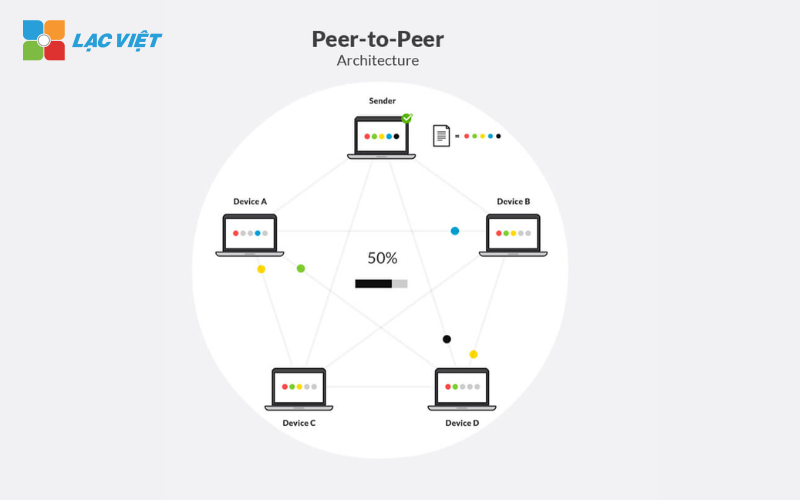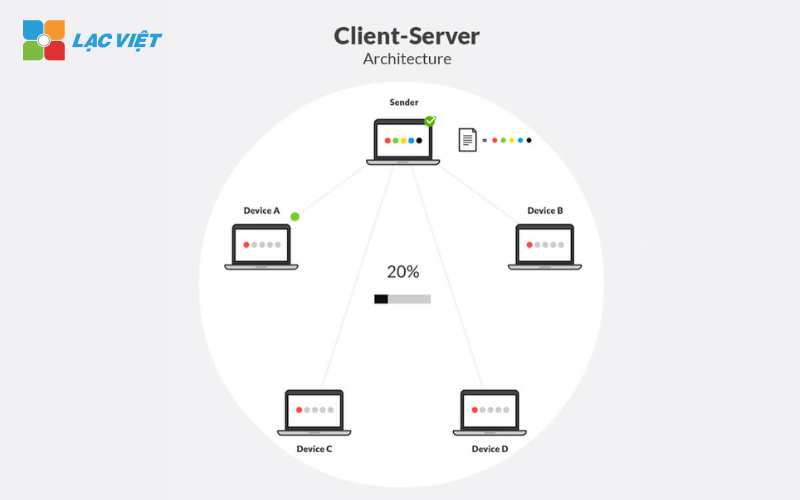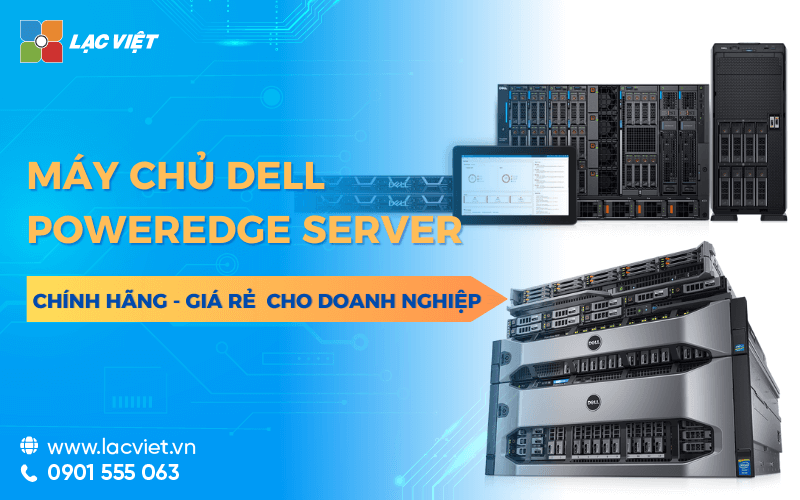Model business network plays an important role in connecting the parts, optimize workflow, data security and create favorable conditions for the sharing of resources. The choice of network model suitable not only meet current needs but also easily adapts to the changes of market, technology.
The same Lac Viet Computing track learn in detail about the network model for today's enterprise and the selection of models suitable for scale, the characteristics field of each business.
1. Network model is what?
Model business network is a system network architecture is designed to connect devices like computers, servers, printers, mobile devices, the other smart devices in a business. This system helps to share resources, information and data between the parts in an efficient manner, while ensuring safety and security.
Why network model business important?
- Thanks to the network, the devices in the enterprise can share data, printers, software from a centralized source.
- Improve the exchange of information between the parts, branches, or between employees with customers.
- Ensure internal data is secured and prevent the threat from outside.
- Business network is designed to be able to easily expand as business grows.
Network models often have to ensure the possibility of stable operation, high performance, flexibility in the expansion of meet the security requirements, as well as data management in the business environment.
- Construction LAN internal quotation construction system LAN STANDARD on the market
- Process construction and installation of network systems & construction unit credits
- 4 standard execution system enterprise network should be noted
- System maintenance network consists of items whatsoever? The maintenance process STANDARD
2. The network model popular business
2.1 Model peer network (Peer-to-Peer)
Model peer network (Peer-to-Peer) is a model in which each computer in the network plays the role just as the client computer (client) is both a server (server). All computers have the right to share resources (data, printers, application) with each other without a central server management. In this system, there is no a clear hierarchy between the computer, each computer can perform the task of transmitting and receiving data.

Model Peer-to-Peer networks, suitable with small businesses, where the number of users. resources need to share less, ask the manager not so complicated. With low-cost, easy to install, small businesses can deploy this network without much investment in hardware and manpower.
Advantages:
- Chi phí thấp: Không cần đầu tư nhiều vào mua Server hay phần mềm quản lý.
- Easy to install use: does Not require knowledge network administrator high.
- Suitable for small groups: the Effect when used in the environment there are number of limited user.
Cons:
- Low security: Because there is no system, centralized management, security information easily compromised.
- Poor performance: When the number of users increases, the system is overloaded, the speed data sharing slow down.
- Difficult to manage: the management of resources and users difficult when the system is expanded.
2.2 Model client – server (Client-Server)
Network model Client-Server is the model network has a central server provides resources for many clients. Server role management, process the request from the client, providing services such as data storage, management, access control app. Client send request to server and get back the data or services from server to use.

This model is usually applied in large enterprises wishing to centralized management of multiple departments or branches. Allows data management easier, enhance the ability to control security as well as performance support works better for organizations with multiple users, connecting device.
Advantages:
- Centralized management: Data is managed in a centralized and easily control updates.
- High security: the System potentially more secure, easy to set up the access rights.
- High performance: in accordance with the system have large number of users, allows to share resources in an efficient way.
Cons:
- Chi phí đầu tư cao: Yêu cầu đầu tư vào enterprise servers cần cấu hình mạnh, phần mềm quản lý, đội ngũ IT có trình độ.
- Depends on the server: If the server crashes, the entire system will be affected.
2.3 Model virtual private network (VPN – Virtual Private Network)
VPN a method allows users to connect to the internal network of the enterprise network through the public Internet, but still ensure safety, thanks to the encryption technology. VPN is often used to secure the connection for employees who work remotely or access to enterprise systems from many different positions.

VPN helps businesses can expand their network to the branch or remote workers, without the need to set up the system physical network at different locations. This reduces the cost significantly and improve flexibility for your business.
Advantages:
- High security: Data transmission via VPN is encrypted, helping protect the information before the risk of attack from the outside.
- Flexible connection: Employees can work remotely in a secure manner that need not be present at the office.
- Cost reduction: cost savings compared to setting up the private network physics.
Cons:
- Performance may be affected: the connection Speed depends on the Internet should there be slower than in the physical network.
- Complex configurations: ask the administrator has knowledge about configuring the VPN to ensure safe performance.
2.4 modeling wireless network (Wireless LAN – WLAN)
Wireless network (WLAN) use radio waves to connect devices in the system network without using a cable. This brings the convenience of deployment, relocation or expansion system. WLAN particularly suitable for businesses that have space to work flexible or modern office.

Many businesses today are applicable model WLAN to support employees to work anytime, anywhere in the campus business which is not restricted by cables. WLAN also support mobile devices, IoT (Internet of Things) in the process of digitization and process automation.
Advantages:
- Convenient and versatile: No need to layout the cable system complex, easy to expand the system.
- High mobility: Employees can move and work in any where in the range of a wireless network.
- Support multiple devices: easily connect mobile devices, IoT devices.
The challenge of security and speed:
- Security inferior: wireless Network vulnerable to attack than wired networks need security measures such as WPA3, firewall, VPN.
- The performance depends on the distance: the connection Speed may decrease as the distance between the device and wireless access point (Access Point) increased.
3. The main components of the network model business
3.1 network devices
The network equipment plays an important role in the connection, management and network security business. Below is the network device basic that every model, business network needs:
- Router (Router): intermediate equipment helps to connect different networks, such as intranet (LAN), wide area network (WAN), or connect the internal network to the Internet. Router navigate the network traffic, choose the best path to send the data from source to destination, while ensuring information security through the security features such as firewall, VPN.
- Switches (Switch): a device for connecting the devices in the internal network (LAN), such as computer, printer, server. It works as a distribution center of data, receive data from a device and send the data to the correct destination device.
- Wireless access point (Access Point): allows wireless devices (such as laptop, smartphone) connected to the internal network. A network system modern casual combination between wired network and wireless to provide flexibility for staff.
3.2 Infrastructure cable connection
The different cables will affect the speed of data transmission, scalability, cost of the system.
- Cable Ethernet (copper Twisted-Pair): Ethernet Cable, usually cable UTP (Unshielded Twisted Pair), is the type of cable's most popular system in the internal network. It connects devices such as computer, printer, switch. Ethernet can transmit data at speeds of 1Gbps (Gigabit Ethernet) or even up to 10Gbps with the modern version.
- Fiber optic cable (Fiber Optic): fiber optic Cable uses light to transmit data with high speed, no electromagnetic interference. Fiber optic cable commonly used in the system wide area network (WAN), connecting the branch or data center, or when requesting data transmission speed between the floors or areas in the business.
- Coaxial cable (Coaxial Cable): coaxial Cable is still used in some systems a special network or to connect older devices. However, with the development of Ethernet cable and fiber optic cable, coaxial cable, increasingly rarely used in the network system modern enterprise.
3.3 The software network management solutions
The software such as SolarWinds, PRTG, Nagios offers the ability to monitor the operation status of the system network from the device such as router, switch, switch to the network service. This software helps detect troubleshooting timely, as well as optimize network performance.
In addition to monitoring the operation status, the solutions such as firewalls (Firewall), system intrusion detection (IDS/IPS), VPN also plays an important role in protecting network traffic monitoring, blocking the attack from the outside.
4. Choosing network model suitable for business
The decision network model which depends on many factors such as scale business user needs, and budget. Here are the main factors that businesses need to consider when choosing network model:
4.1 Based on scale business
- Small business (Small Office/Home Office – SOHO): Với các doanh nghiệp nhỏ hoặc văn phòng tại nhà, triển khai thi LAN với cấu hình đơn giản thường đủ để đáp ứng nhu cầu. Mô hình LAN cơ bản với router không dây tích hợp là lựa chọn tối ưu, cung cấp khả năng kết nối không dây cho các thiết bị di động.
- Medium enterprises (SME): A LAN system in combination with the wireless network (WLAN) will better meet the needs, this allows many users connect at the same time, at the same time management is the flow and division of bandwidth. Use switch management Access Point dedicated to partition the network, providing Wi-Fi coverage the entire office.
- Big business, corporations (Enterprise): Wide area network (WAN) or virtual private network (VPN) can be the solution, in conjunction with the security system, complex management. Model WAN combined with the VPN to connect the branch, use the solution robust security such as firewall, IDS/IPS, MPLS to ensure data safety.
4.2 Based on field activity
- Business, technology, finance: Businesses in this sector often need to speed fast data transmission, the ability to handle big data, high security. The system optical network (Fiber Optic) may be the optimal choice with a large bandwidth and the ability to transmit high-speed data.
- Business, ecommerce, online services: These businesses often have massive traffic and requires fast response time. Network model need to ensure scalability to meet growth in traffic, along with the ability to backup data online. Use the system Load Balancer, Data Center, dispersion, combined with the Cloud solutions to optimal performance.
- Business manufacturing, industry: need stable network to operate the automation system, production management (SCADA), Internet of Things (IoT). Network need to be able to meet the demand for real-time monitoring, stable connection between the industrial equipment. Apply models for industry, combined with monitoring solutions IoT system and remote management to ensure production performance.
4.3 Based on the investment budget
- Ngân sách hạn chế: thường ưu tiên các giải pháp có chi phí thấp, dễ lắp đặt và system maintenance network sau triển khai. Mô hình LAN cơ bản hoặc mạng không dây với thiết bị tiêu chuẩn thường là lựa chọn tốt, giúp tối ưu hóa chi phí.
- Average budget: Enterprise with moderate budget can invest in the network system with the ability to manage higher security. The use of the equipment, Switch management, the Router, the Access Point high-level can improve the network performance, which is still within the cost limits.
- High budget: Enterprise with high budget can consider the deployment of complex network system as WAN, VPN, the Cloud solutions. Network devices such as firewall, IDS/IPS devices, load balancing will ensure the security and performance works best for the system.
5. Vietnam – more Than 30 years experience in design and construction systems business network
Vietnam, with more than 30 years of experience in the design and construction and installation of network systemsproud to be a trusted partner of many large and small businesses on the market. We not only provide solutions comprehensive network but also always strives to improve the quality of service through the consulting process network design for business and deploy professional, ensure the efficiency, safety and security for the system network of the customer.
With a team of IT technicians, experienced, trained, Vietnam committed to bringing the business network system, optimum performance, easy to expand as business grows. In particular, we focus on the optimization of the budget, help customers choose the solution that best fits the current needs and development roadmap in the future. Network system due to Lac Viet deployed not only meet the requirements of security with the advanced technology, but also ensure the flexibility, ease of management, helping business peace of mind operation to focus on core activities, other.
Vietnam also pays special attention to the scalability of the system, ensure that the system network can grow with the growth of the business. That is why many large businesses have come to trust and choose us Vietnam to build infrastructure and platform network firm, to help optimize workflow, asset protection important information.
VIEW DETAILED NETWORK SOLUTION FROM VIETNAM
>> Xem thêm các dịch vụ hạ tầng mạng khác của Lạc Việt
- Dell servers poweredge chính hãng
- Dịch vụ IT cho doanh nghiệp trọn gói
A model business network properly designed not only helps to optimize work performance but also brings peace of mind about security and scalability in the future. With the increasing demands of complex diversity, the selection of models suitable network is a strategic decision directly affects the operation development of the business. Invest in network system not only is investment for the present, but also the stepping stone solid for the long-term development in the digital era.














